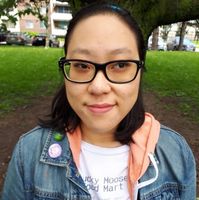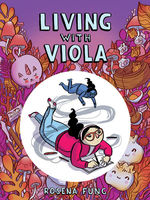"You're Not Alone" Rosena Fung Explores Childhood Anxiety in Her Insightful Graphic Novel Debut
It's tough enough being the new girl in school. But for Livy, the biggest complication is Viola. Not quite a friend, not quite a twin, Viola is always with her. The only thing is, no one else can see Viola. Because for Livy, Viola is a part of her—one of the most complicated parts. Viola is an external manifestation of the anxiety Livy lives with; a way of relating to and processing this new element of her life that has emerged as she enters middle school.
And so we enter the smart, complex world created by Rosena Fung in Living with Viola (Annick Press), Fung's debut graphic novel, for which she both wrote the script and created the artwork.
Funny, relatable, and at times heartbreaking, Living with Viola is a clever exploration of a common and deeply challenging mental health issue, for which Fung drew on her own experience both with anxiety and as a new kid and child of immigrant parents trying to fit in. Her rich, colourful, imaginative artwork opens a world for young readers to connect with the charming and tough Livy.
We're talking to Rosena today as part of our new interview series for graphic novelists. She tells us about her own experiences that inspired Livy and the story, makes us wish for a tour of her studio (cute plushies and mini toys!), and explains both the toughest part and her absolute favourite part of the entire graphic novel creation process.
Open Book:
Tell us about your new book and how it came to be.
Rosena Fung:
Living With Viola is a graphic novel about Livy, who is about to start Grade 6 at a brand new school. It follows her as she navigates a new environment, finding new friends, and her family, as she also struggles with anxiety. Livy's anxiety is personified in the form of a shadowy-twin named Viola, who voices all of Livy's deepest insecurities, doubts, and fears until it becomes debilitating. Throughout the book, Viola learns to live alongside Viola: in other words, she learns to live with and manage her anxiety.
The book is based on my own personal experiences with anxiety. I too started experiencing a lot of anxiety around the same age as Livy, but lacked the language to articulate what I was going through. A lot of Livy's coping mechanisms and interests are the same as mine, that have helped me through rough times. I wanted to write this story, because it's my own story.
OB:
Is there something you hope readers get from reading your book or a subject you hope to bring more attention to that is contained in your story?
RF:
Asking for help is one of the biggest takeaways I'd want readers to get: you're not alone, and there's help and support for you. I'm hoping that Living With Viola will help readers who experience anxiety know that they're not alone. I also hope readers who don't experience anxiety can get insight on what it can feel like, so that they can be supportive to those around them who do. The book is also about embracing things that you love, no matter what others may say about them, whether that be your favourite books, drawing subject matter, your family, or what you eat.
OB:
What was the strangest or most memorable moment or experience during the creative process for you?
Your CanLit News
Subscribe to Open Book’s newsletter to get local book events, literary content, writing tips, and more in your inbox
RF:
A lot of the whole process was so much fun and a pleasure to work on. That said, half of the book was worked on during the pandemic. In Ontario, we had our first lockdown in March 2020, and I had just gotten final approval on the script. During this tumultuous time, I finished the rest of the book, which was a surreal experience. In a lot of ways, working on Living With Viola kept me anchored and prevented me from spiralling too much. Knowing I had goals to work towards, something that I loved working on so much, was a boon. I don't want to overstate the case for productivity during a pandemic, because those expectations are unreasonable. But on a personal level, working on the book help me feel grounded during an extraordinary time.
OB:
What do you need in order to write and create your artwork – in terms of space, food, rituals, writing instruments?
RF:
My studio is at home, and it's surrounded by my favourite things: lots of colourful mini toys, illustration prints, postcards, cute plushies, and silly novelty pens and pencils. I love being surrounded by so much colour and whimsy and lots and lots of patterns. And of course, it's full of many, many art supplies. For this book, I used mostly brush pens and fineliners on bristol paper so I have a lot of these. I love snacks so there's always some kind of food on my desk, and I'm next to the kitchen which is really ideal. There's also an acoustic guitar I keep next to me which I play really poorly but I love it, and it's a great way to step away from the work sometimes and take a break. Something I always try to do is spend a little bit of time every night to read. I love reading so much!
OB:
Do you feel like there are any misconceptions about writing graphic novels? What do you wish people knew about what you do?
RF:
It takes really long, and it's not a hobby! Comics and graphic novels have come a long way since I was a kid, and is now regarded as a literary medium (vs being juvenile or “trash” literature). Even still, writing a book, or working on art, or both is easily dismissed and undervalued in society. There is a strong sense of work/labour hierarchy that ascribes arbitrary value to different kinds of work. Many people want and expect art to be free and don't see the skill, experience, and time that goes behind producing any kind of creative work. And because a book takes so long to write (often years), not having immediate tangible results sometimes makes it feel like what we're working on is futile or not part of society's definitions of what it means to be productive.
Also, writing a book/GN is all about balancing other aspects of your life. Since it does take so long, I've had to learn how to manage work/life balance: working other jobs, domestic work, managing different projects, seeing family and friends. It's a juggle!
OB:
Was there a graphic novel or comic series you read as a young adult that is particularly meaningful to you?
RF:
When I was young, graphic novels were nowhere near as big as they are now. One of the most foundational comics I read was For Better of For Worse by Lynn Johnston and Calvin and Hobbes by Bill Watterson. I read a lot of newspaper syndicated comics and pored over them extensively to learn about timing, pacing, writing, story arcs.
OB:
What's your favourite part of the life cycle of a graphic novel project? Writing, artwork, revision, talking about the finished project with readers, etc.? What's the toughest part?
RF:
I love inking! It's so much fun and very relaxing. I just pop on a movie or show on Netflix or just listen to music and ink all day and night. And now that the book is out in the world, I absolutely love seeing it being read, especially by kids.
By far the toughest part is writing! It's not streamlined in the way the drawing process is for me. There's a lot of accessing personal experiences and being vulnerable and writing consistent and fully-fleshed out characters in a compelling story arc that requires a lot of rewriting, revisiting, rehauling that can be frustrating. Ahh, but it's always worth it!
________________________________________________
Rosena Fung is an illustrator and comic artist from Toronto, Ontario. Her work has appeared in newspapers, magazines, giant murals, and on TV. Her favourite things are reading, cats, and eating snacks.





